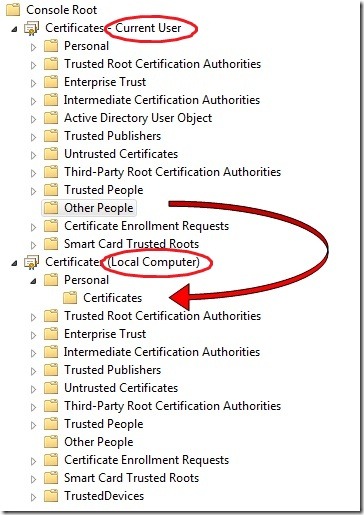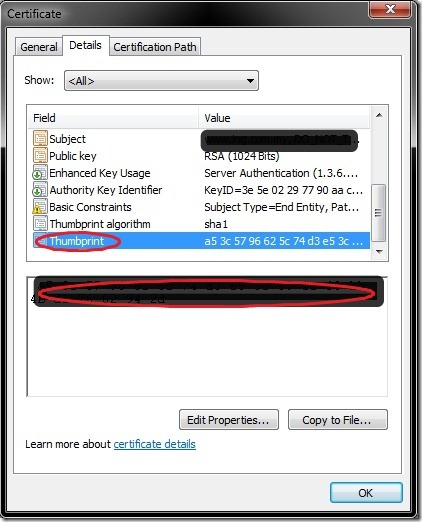CertEnroll::Cx509Enrollment::p_InstallResponse: ASN1 bad tag value met. 0x8009310b
Recently while installing a SSL certificate on IIS 7.0 I got this error message
CertEnroll::Cx509Enrollment::p_InstallResponse: ASN1 bad tag value met. 0x8009310b
I could not complete the certificate request via IIS manager.
But strangely after this error the certificate was placed in the Other People certificate store.
Only certificates that are stored in the Local Computer store can be used in IIS.
To restore the certificate to the Local Computer store you can load the two Certificates MMC (Local Computer & Local User). Drag it out of the Other People store and drop it under the Local Computer > Personal > Certificates.
But if you double click the certificate you will see that the private key is missing. Without a private key the certificate is worthless as even if you configure it on your website in IIS you will end up getting Page Cannot Be Displayed.
Now if the request for the certificate was issued from the same machine you can use the command below to restore the private key for your certificate.
certutil –repairstore my “00 01 02 03 04 05 06 07 08 09 0a 0b 0c 0d 0e 0f”
The sequence in the quotes is the thumbprint of the SSL certificate.
This should restore the private key for that certificate. You should see a “You have a private key that corresponds to this certificate” message when you open it .
Now the certificate is installed in your Local Computer certificate store so you go into your website properties and assign the certificate by changing the bindings settings.
Comments
Anonymous
November 25, 2008
PingBack from http://blog.a-foton.ru/index.php/2008/11/25/certenrollcx509enrollmentp_installresponse-asn1-bad-tag-value-met-0x8009310b/Anonymous
November 29, 2008
This was amazingly helpful. I had this exact issue, and nowhere was there help to be found - not Verisign, not Microsoft. This post had me up and running in about 30 seconds.Anonymous
December 04, 2008
The comment has been removedAnonymous
December 06, 2008
WOW! Great article. Like the other posters I had the SSL problem and was up and running following this exactly. Thanks A LOT man!! =]Anonymous
December 09, 2008
Following your post fixed the problem in 2 minutes after I wasted 2 hours with certificate and the issuer. Thank You, Thank You, Thank You!!!Anonymous
December 30, 2008
The comment has been removedAnonymous
January 03, 2009
We’ve seen a few instances of the following error message on 64 bit servers when IIS 7.0 is attemptingAnonymous
January 06, 2009
Also with me this helped. If you have the same error? Try this solution out.Anonymous
February 11, 2009
I have no "other people" folder. Suggestions?Anonymous
March 10, 2009
Great! I was nearly desperate, because I had never had problems with ssl-certificates on different Linux- and IIS6-Webservers. Thank you very much for this article! Kind regards, VolkerAnonymous
April 07, 2009
This is a very odd error you discovered. Your work-around likely saved me hours. There is a special place in the after-life for people like you.Anonymous
May 19, 2009
I have no "other people" folder. What do I do? Regards Pablo. pgonzalez@fsnsolutions.com.auAnonymous
May 21, 2009
Pablo Check this http://support.microsoft.com/kb/959216Anonymous
December 21, 2009
how do i get to the screen shown?Anonymous
February 04, 2010
Good job Buddy really saved my neck. Works like a charm !!! ThanksAnonymous
March 12, 2010
You saved me on this. GoDaddy was no help at all. Thanks.Anonymous
April 28, 2010
Thanks Vijay , Very userful information for fixing certificate for unpaired priovate key.Anonymous
September 06, 2010
Thanks! To load the two Certificates MMC (Local Computer & Local User), this is helpful: msdn.microsoft.com/.../ms788967.aspx just drag and drop the certificate to Local Computer > Personal > Certificates. Run the repair with your own thumbprint, and ready in 30 seconds!!Anonymous
October 13, 2010
Great article, very helpful. Thanks.Anonymous
November 12, 2010
It would have been a great time saver if OP would have posted how to get to the console screen or that the snap in is not installed by default!@!!@!@ Thank so much to Arno for posting the link on how to do this and install the snap in.Anonymous
December 14, 2010
This worked great. I instead skipped the step of trying through IIS, since it always fails on me, so I just import the SSL into the local computer personal certificates folder, and run the script to repair based on the thumb print. One less step, just as effective. Thanks again, TAnonymous
May 17, 2011
Thanks NK, very useful tip, you are a lifesaver.Anonymous
July 25, 2011
3 years and still a working solution :) thanksAnonymous
January 20, 2012
THIS. SAVED. MY. BIG. TIME!!! Thanks! :)Anonymous
April 16, 2013
Saved my hide ! Great job - thanks a ton !Anonymous
July 03, 2013
I get a "Insert smart card"? What now?


